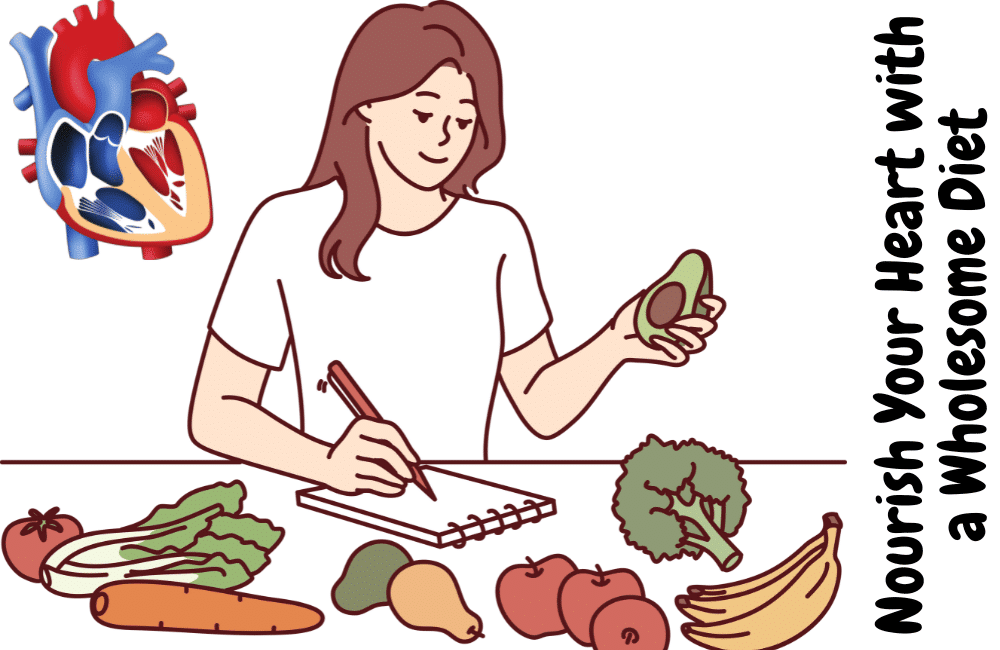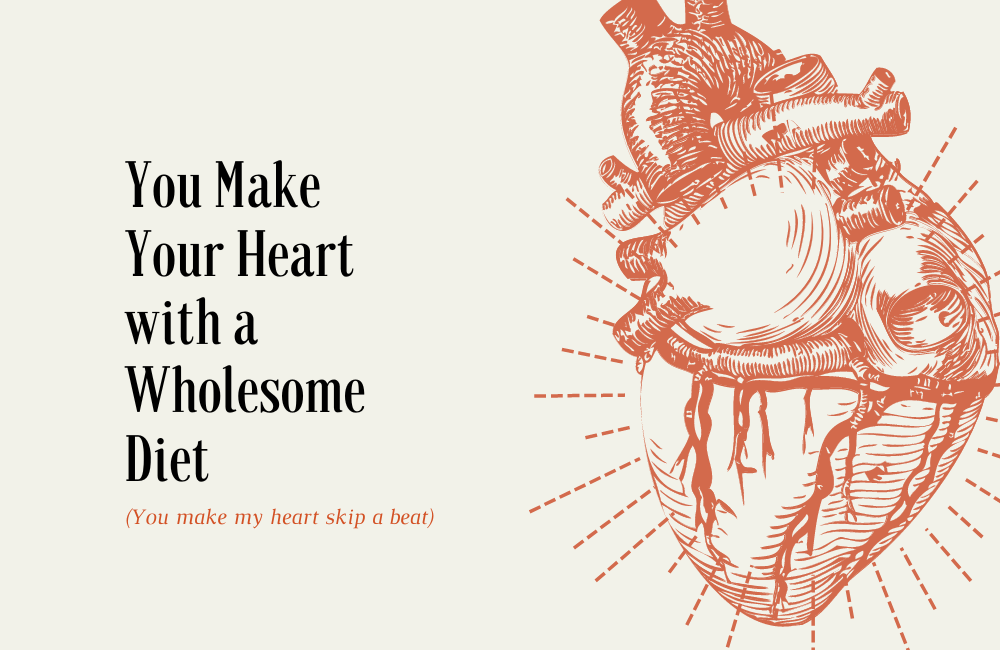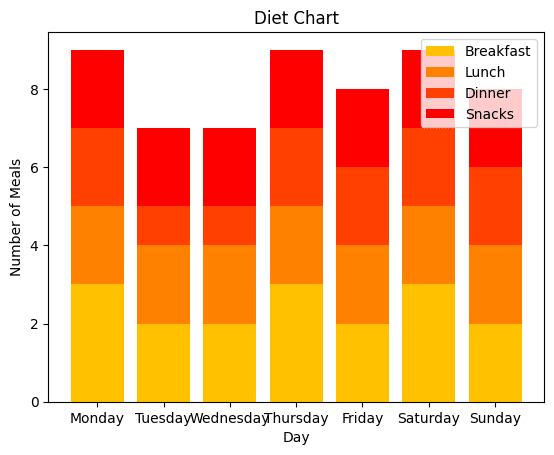Heart disease is the leading cause of death. It can affect anyone, regardless of age, gender, or ethnicity. However, you can lower your risk of developing heart disease by following a wholesome diet that supports your heart health.

A wholesome diet for heart health emphasizes whole, minimally processed foods rich in fiber, healthy fats, and antioxidants. It also limits or avoids foods high in saturated fat, sodium, added sugar, and processed meats.
In this article, we will explain why these foods are good or bad for your heart and provide some examples of how to include them in your diet. We will also show you how to create a simple meal plan that follows the principles of a heart-healthy diet.
Why are fiber, healthy fats, and antioxidants good for your heart?
Fiber is a type of carbohydrate that your body cannot digest. It helps lower your cholesterol levels, regulate your blood sugar levels, and keep you feeling full longer. Fiber also feeds the beneficial bacteria in your gut, which may have anti-inflammatory effects on your body.

Healthy fats are unsaturated fats found in nuts, seeds, avocados, olive oil, and fatty fish. They help lower LDL (bad) cholesterol levels and increase HDL (good) cholesterol levels. They also help reduce inflammation and improve blood vessel function.
Antioxidants protect your cells from damage caused by free radicals, which are unstable molecules that can cause oxidative stress. Oxidative stress can contribute to aging, inflammation, and chronic diseases like heart. Antioxidants are abundant in fruits, vegetables, herbs, spices, tea, coffee, and dark chocolate.
Why are saturated fat, sodium, added sugar, and processed meats bad for your heart?
Saturated fat is a type of fat that is solid at room temperature. It is found in butter, cheese, cream, fatty meats, and coconut oil. Too much-saturated fat can raise your LDL (bad) cholesterol levels and increase your risk of heart.
Sodium is a mineral that helps regulate fluid balance and nerve function in your body. However, too much sodium can raise your blood pressure and strain your heart and blood vessels. Most of the sodium in our diet comes from processed foods like bread, cereals, snacks, sauces, soups, and fast foods.
Added sugar is any sugar not naturally present in foods like fruits and milk. It is added to foods and drinks to enhance flavor, texture, or shelf life. Examples of added sugars include table sugar, honey, maple syrup, agave nectar, corn syrup, and high-fructose corn syrup. Too much added sugar can increase triglyceride levels (fat in your blood), cause weight gain and obesity (risk factors for heart disease), and increase inflammation.
Processed meats have been cured, smoked, salted, preserved, or modified to enhance their flavor or shelf life. They include bacon, ham, salami, hot dogs, sausages, pepperoni, and deli meats. Processed meats are high in sodium, nitrates, nitrites, and other chemicals that can damage blood vessels and increase cancer risk.
How to include more heart-healthy foods in your diet
You don’t need to follow a strict meal plan or count calories to nourish your heart with a wholesome diet. You just need to change your food choices and cooking methods. Here are some tips to help you eat more heart-healthy foods:
• Choose whole grains over refined grains. Whole grains contain more fiber, vitamins, minerals, and phytochemicals than refined grains. They also have a lower glycemic index (GI), which means they cause fewer spikes in your blood sugar levels. Whole grains include oats, barley, quinoa, brown rice, buckwheat, whole wheat bread, and pasta.
• Eat at least five servings of fruits and vegetables per day. Fruits and vegetables contain antioxidants, fiber, and water to help lower your blood pressure, cholesterol levels, and inflammation. They also add color, flavor, and texture to your meals and snacks. Try to eat various fruits and vegetables of different colors to get the most benefits. A serving is about a cup of raw or cooked vegetables, a medium-sized fruit, or half a cup of dried fruit.
• Include nuts, seeds, and legumes in your diet. Nuts, seeds, and legumes are excellent sources of plant-based protein, healthy fats, fiber, minerals, and phytochemicals. They can help lower your cholesterol levels, blood pressure, and inflammation. They also keep you feeling full longer and prevent overeating. Examples of nuts include almonds, walnuts, cashews, pistachios, and pecans. Examples of seeds include chia, flax, hemp, pumpkin, and sunflower seeds. Examples of legumes include beans, lentils, peas, soybeans, and peanuts.
• Choose fish and poultry over red and processed meats. Fish and poultry are leaner animal protein sources than red and processed meats. They also contain more omega-3 fatty acids, which benefit your heart health. Fish high in omega-3s include salmon, tuna, sardines, mackerel, and herring. Poultry that are low in fat include chicken breast, turkey breast, and skinless chicken or turkey. Aim to eat at least two servings of fish per week and limit your intake of red and processed meats to no more than one serving per week.
• Use olive oil instead of butter or margarine. Olive oil is a healthy fat that can help lower LDL (bad) cholesterol levels and increase HDL (good) cholesterol levels. It also contains antioxidants and anti-inflammatory compounds that protect your blood vessels from damage. Use olive oil for cooking, baking, dressing salads, and dipping bread. Choose extra virgin olive oil for the highest quality and flavor.
• Limit your intake of added sugars and salt. Added sugars and salt can increase your risk of heart disease by raising your blood pressure, triglyceride levels, and inflammation. They can also contribute to weight gain and obesity, risk factors for heart disease. Avoid foods and drinks high in added sugars and salts, such as sodas, candies, cakes, cookies, pastries, ice cream, jams, sauces, soups, and fast foods. Instead, sweeten your foods and drinks with natural sugars from fruits or honey (in moderation), and flavor your foods with herbs, spices, vinegar, lemon juice, or low-sodium sauces. Aim to consume no more than 6 teaspoons (25 grams) of added sugar and no more than 1 teaspoon (2,300 mg) of salt daily.
How to create a simple meal plan for heart health
To help you get started on a heart-healthy diet, here is a sample meal plan for one week. You can adjust the portions and ingredients according to your preferences and calorie needs. You can also swap the meals around or repeat them as you like.
| Day | Breakfast | Lunch | Dinner | Snacks |
|---|---|---|---|---|
| Monday | Oatmeal with fresh berries and chopped walnuts. A glass of orange juice. | Greek salad with lettuce, tomatoes, cucumbers, olives, feta cheese, and grilled chicken. Whole wheat pita bread with hummus. A cup of green tea. | Baked salmon with lemon and herbs. Roasted potatoes and broccoli. A glass of red wine. | A handful of almonds. A banana. |
| Tuesday | Scrambled eggs with spinach and cheese. Whole wheat toast with avocado. A cup of coffee. | Turkey sandwich with whole wheat bread, lettuce, tomato, and mustard. Carrot sticks with ranch dressing. A cup of low-fat yogurt. | Vegetable stir-fry with tofu, brown rice, and soy sauce. A bowl of fresh fruit salad. | A granola bar. A cup of blueberries. |
| Wednesday | Whole wheat pancakes with sliced bananas and honey. A glass of milk. | Lentil soup with whole wheat crackers. A green salad with olive oil and vinegar dressing. A cup of black tea. | Spaghetti with whole wheat pasta, tomato sauce, and lean ground beef. Steamed asparagus. A slice of whole wheat bread with butter. | A piece of dark chocolate. An apple. |
| Thursday | Greek yogurt with granola and dried cranberries. A glass of grapefruit juice. | Chicken and vegetable wrap with whole wheat tortilla, lettuce, tomato, cheese, and salsa. Corn on the cob with butter. A cup of low-fat milk. | Roasted chicken breast with rosemary and garlic. Mashed potatoes and green beans. A glass of water. | A handful of pistachios. A pear. |
| Friday | French toast with whole wheat bread, eggs, milk, cinnamon, and maple syrup. A cup of coffee. | Ham and cheese omelet with mushrooms and onions. A whole wheat muffin with jam. A glass of milk. | Grilled steak with mushroom sauce. Baked potato with sour cream and chives. Roasted Brussels sprouts. A glass of red wine. | A slice of cheesecake. A cup of strawberries. |
| Saturday | Ham and cheese omelet with mushrooms and onions. Whole wheat muffin with jam. A glass of milk. | Chicken noodle soup with whole wheat noodles and vegetables. A cheese sandwich with whole wheat bread and mustard. A cup of green tea. | Fish tacos with whole wheat tortillas, cabbage slaw, avocado, and lime juice. Black beans and rice. A glass of water. | Popcorn with butter and salt. A cup of grapes. |
| Sunday | Smoothie with banana, spinach, almond milk, peanut butter, and cocoa powder. A slice of whole wheat toast with butter. | Vegetable lasagna with whole wheat noodles, ricotta cheese, mozzarella cheese, and tomato sauce. A green salad with olive oil and vinegar dressing. A glass of water. | Roasted pork loin with apple sauce. Quinoa and roasted carrots. A glass of apple cider. | Ham and cheese omelet with mushrooms and onions. A whole wheat muffin with jam. A glass of milk. |

Final Thoughts
A wholesome diet for heart health emphasizes whole, minimally processed foods rich in fiber, healthy fats, and antioxidants. It also limits or avoids foods high in saturated fat, sodium, added sugar, and processed meats.
A heart-healthy diet can lower your risk of developing heart disease and other chronic diseases. You can also enjoy a variety of delicious foods that nourish your body and mind.
To help you get started, we have provided a sample meal plan for one week that follows the principles of a heart-healthy diet. You can use it as a guide or create your meal plan based on your preferences and needs.
Remember that a heart-healthy diet is not only good for your heart but also for your overall health and well-being. So start today and make your heart happy!

